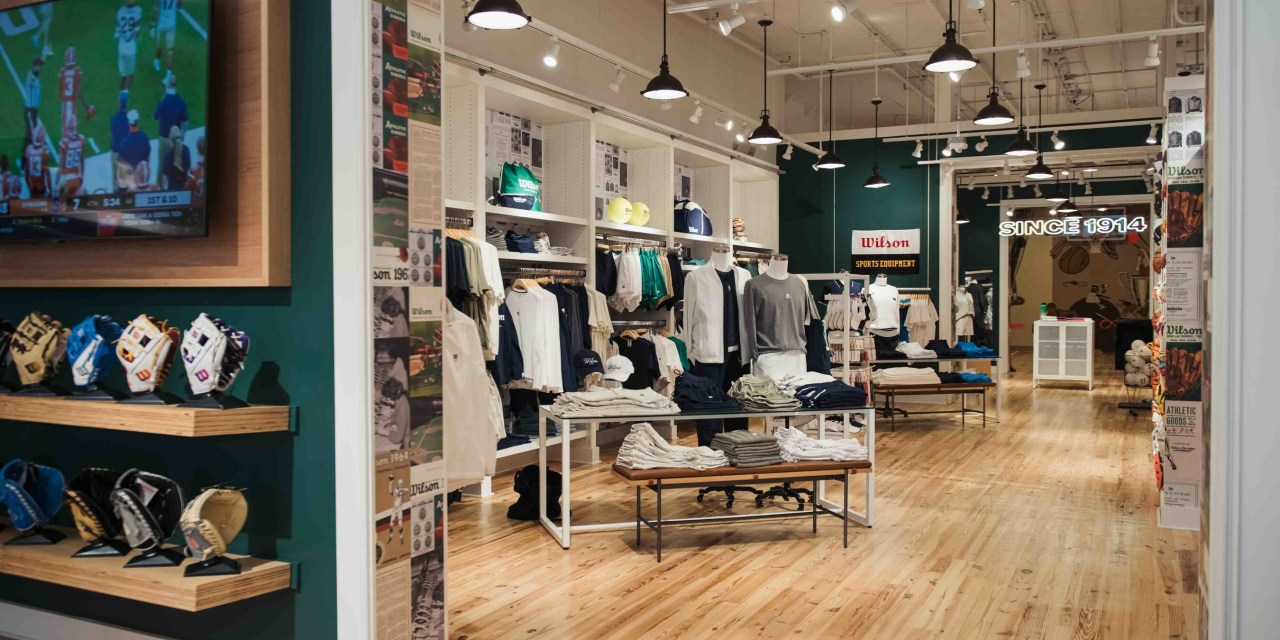Why Wilson Sporting Goods is focusing on brick-and-mortar retail

Wilson Sporting Goods, a brand with well over a century of history in offering equipment to athletes, is new to the brick-and-mortar playing field.
Its physical retail journey began in July 2021 in its hometown, Chicago, where it opened its standalone 2,247-square-foot store. Its newest and first West Coast store opened last week in Santa Monica, California. Wilson now has six locations in the U.S. that feature its assortment of apparel and sports equipment with three more planned for this year.
Founded in 1914, Wilson has made its name as one of the most recognizable American athletic brands selling equipment in a range of sports from tennis rackets and baseball gloves to golf balls and pickleball paddles. But up until recently, its physical retail presence mainly had been through its extensive network of wholesale partners — like Dick’s Sporting Goods and Academy Sports + Outdoors — and pop-up shops at major sporting events such as the Super Bowl, College World Series, and tennis’ U.S. Open.
For many retail brands, physical stores are not only a sales channel but also a medium to market the brand’s purpose and story to shoppers. Through brick-and-mortar retail, Wilson wants to tell the brand’s athletic roots directly to shoppers in an in-person setting. For example, Wilson’s Chicago store features archival photos and catalog covers throughout the space.
“We got to a point where for us to continue to elevate the product, to continue to elevate the technology — the innovation that we always strive to put into our products — we recognize that we need to create a new level of retail,” said Gordon Devin, president and general manager of Wilson Sportswear. “We felt that we were the only people that could really tell the most premium story about our products and our brand.” The company declined to share details on its revenue growth.
Inside Wilson stores, shoppers can find some of the brand’s newest styles, top sporting equipment and assortment that are suited to the location. It also holds experiential components and unique services. For example, the new Santa Monica store has a play/test area — like a basketball hoop, hitting wall and on-site racket stringing — for shoppers to try products. Its flagship Soho store offers services like ball customization and glove personalization.
Wilson chooses to open stores in areas with a significant population of athletes as they are the brand’s average customer demographic, Devin said. Events are often held in stores for Wilson customers in the area to gather together. Apart from the U.S., the company is also starting to roll out stores overseas, including China.
Ad position: web_incontent_pos1
“If I look at things like units per transaction and average transaction value, they’re really impressive in our direct-to-consumer business,” Devin said. “Athletes come and buy multiple items every time they come into a store or online.”
Wilson’s rollout of retail stores goes hand in hand with its investments in categories like apparel and footwear. Months before the launch of its first store, the company unveiled its first lifestyle apparel collection back in 2021 and, a year later, launched a performance-based tennis collection.
“Within the last three years, what’s really happened is that Wilson is showing up to the world as a bigger, bolder, better version of itself than we ever had before,” Devin said. “We have many great wholesale partners, but the best place to really experience the best of this brand is in a retail store.”
Beth Goldstein, footwear industry analyst at Circana, said that brands are becoming more compelled to explore different channels in order to be top of mind for shoppers and grow their customer base. By selling directly to consumers, she said brands have more control over their messaging. Athletic brands like Nike and Adidas have previously stated their plans to have DTC generate a larger portion of their business.
“Obviously, the brand is pretty well ingrained in the sporting goods space, but even the best retailers in that space can’t really tell the Wilson brand story,” she said.
Ad position: web_incontent_pos2
However, she said in order to draw in foot traffic, brands that invest in physical stores have to invest in the location as well — which can be pricey.
Despite Wilson’s direct-to-consumer push, Devin said that wholesale will still make up the bulk of its business. “You will see our direct-to-consumer business become more and more evident, prevalent and much, much larger,” he said. “But no, I sincerely believe that the majority of our business will continue to be wholesale for many years to come.”

